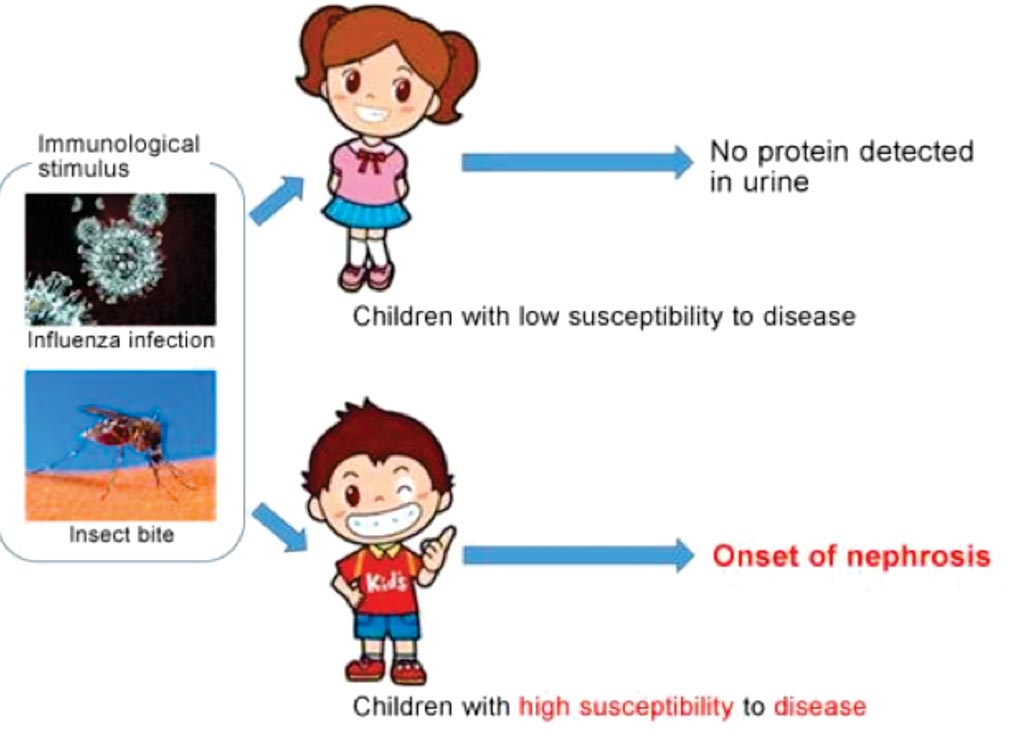Susceptible Genes Identified for Childhood Kidney Disease
By LabMedica International staff writers
Posted on 09 Aug 2018
Childhood nephrotic syndrome, also known as nephrosis, is an incurable disease with an unknown cause, characterized by large amounts of protein leaving the body in the patient's urine, and protein levels in the bloodstream becoming extremely low.Posted on 09 Aug 2018
The majority of patients develop steroid-sensitive nephrotic syndrome that responds to steroids and immune-suppressing drugs, and go into remission, but at least 20% of cases are resistant strains that recur repeatedly during adulthood. It is thought that people who are genetically predisposed develop the syndrome when exposed to an immunological stimulus such as infection.

Image: A diagram of the hypothesis for the onset mechanism of childhood steroid-sensitive nephrotic syndrome (Photo courtesy of Kobe University).
A team of scientists working with those at the Kobe University Graduate School of Medicine (Kobe, Japan) conducted a genome-wide association study (GWAS) in the Japanese population; 224 patients with childhood steroid-sensitive nephrotic syndrome (SSNS) and 419 adult healthy controls who were genotyped using the Affymetrix Japonica Array in the discovery stage. Imputation for six HLA genes (HLA-A, -C, -B, -DRB1, -DQB1, and -DPB1) was conducted on the basis of Japanese-specific references.
The investigators performed genotyping for HLA-DRB1/-DQB1 using a sequence-specific oligonucleotide-probing method on a Luminex platform. Whole-genome imputation was conducted using a phased reference panel of 2,049 healthy Japanese individuals. Replication was performed in an independent Japanese sample set including 216 patients and 719 healthy controls. They genotyped candidate single-nucleotide polymorphisms using the DigiTag2 assay.
The scientists identified single nuclear polymorphisms (SNPs) with a significant genome-wide association in the HLA-DR/DQ area of the short arm of human chromosome 6. They then identified the HLA haplotypes (gene groups) with the lowest and highest risks of developing the syndrome. They confirmed this result with the second independent cohort of 213 samples of infant steroid-sensitive nephrotic syndrome and their controls. The HLA haplotype showing the highest risk of development is HLA-DRB1*08:02-HLA-DQB1*03:02 and the HLA haplotype showing the lowest risk of development is HLA-DRB1*13:02-HLA-DQB1*06:04. This is the first time these haplotypes have been identified to such a high degree of precision.
Kazumoto Iijima, MD, a professor of Pediatrics and first author of the study, said, “With this study there is a high possibility that we will be able to identify other susceptible genes. In the future we would like to engage in international collaboration to confirm whether the susceptible genes are the same for people worldwide.” The study was published on July 16, 2018, in the Journal of the American Society of Nephrology.
Related Links:
Kobe University Graduate School of Medicine













